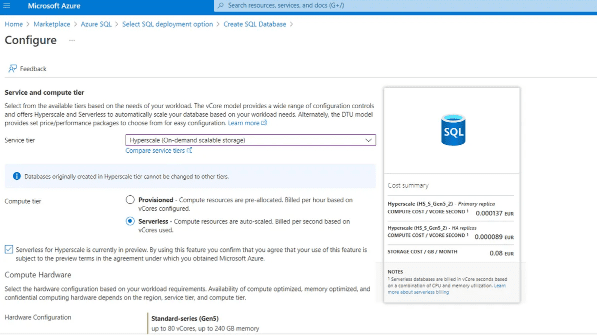Microsoft announces the preview of serverless Azure SQL Database
Microsoft has announced a preview of the serverless for Hyperscale in the Azure SQL database; bringing the benefits of Hyperscale and serverless into a single solution.
Azure SQL Database is a managed cloud-based database service, available in several formats based on the purchase model, deployment model, service tier, compute model, and hardware types.
Customers can choose between three service tiers: General Purpose (default), Business Critical, and Hyperscale.
Hyperscale is suitable for all workload types and provides independently scalable storage options to support the widest variety of traditional and modern applications.
The serverless compute tier is available within the default General Purpose tier and exists as a preview within the Hyperscale tier. It’s intended for single databases in Azure SQL Database that automatically scales compute depending on the demand of workload and bills for the compute used per second.
On top of that, it also automatically pauses databases during inactive periods when only storage is being billed and automatically resumes databases when activity starts again.
A Microsoft program manager has clarified that auto-pausing/auto-resuming is available now in General Purpose serverless, but not yet supported in Hyperscale serverless.
Benefits of going serverless
No server management
Although serverless computing does actually take place on servers, developers never have to deal with the servers. They are managed by the vendor. This can reduce the investment necessary in DevOps, which lowers expenses, and it also frees up developers to create and expand their applications without being constrained by server capacity.
Developers are only charged for what they use
Code only runs when backend functions are needed by the serverless application, and the code automatically scales up as needed. Provisioning is dynamic, precise, and real-time. Some services are so exact that they break their charges down into 100 millisecond increments. In contrast, in a traditional server-full architecture, developers have to project in advance how much server capacity they will need and then purchase that capacity, whether they end up using it or not.
Inherently scalable
Applications built on a serverless infrastructure can scale automatically as the user base grows. If a function needs to be run over several instances, the vendor’s servers will start up, run, and end as needed, often via containers. As a result, a serverless application can handle an unusually high number of requests just as well as it can process a single request from a single user.

Quick deployments and updates
Using a serverless infrastructure, there is no need to upload code to servers or do any backend configuration in order to release a working version of an application. Developers can very quickly upload bits of code and release a new project. Serverless architectures also make it possible to quickly update, patch, and fix.
Using a serverless infrastructure, there is no need to upload code to servers or do any backend configuration in order to release a working version of an application. Developers can very quickly upload bits of code and release a new project. Serverless architectures also make it possible to quickly update, patch, and fix.
A principle program manager at Microsoft explained in depth in a recent Azure SQL blog post:
Serverless Hyperscale (preview) optimizes price performance and simplifies performance management for databases with intermittent and unpredictable usage while leaving headroom for growing to extreme scale and delivering high performance during active usage periods.
Serverless Hyperscale is also well-suited for new applications with compute sizing uncertainty or workloads requiring frequent rescaling in order to reduce costs. The serverless compute tier for Hyperscale helps accelerate application development, minimize operational complexity, and lower total costs.


